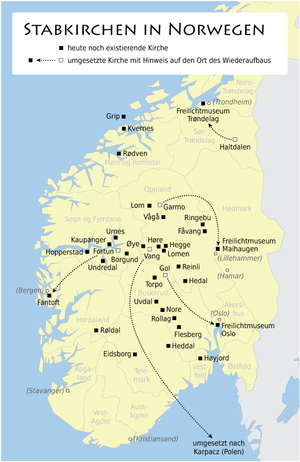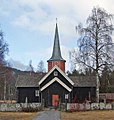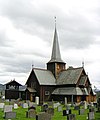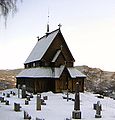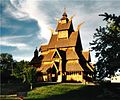List of stave churches
The list of stave churches lists both the authentic stave churches that still exist today with a medieval high column construction inside, as well as replicas of stave churches from more recent times. Of the 750 or so stave churches, there are now only 30 authentic stave churches. 28 are in Norway. A stave church outside Norway that has survived from the Middle Ages is Hedared stave church in Sweden . A stave church translocated from Norway is Wang Church in Poland.
Type A stave churches are single-nave churches with a maximum of one central mast, type B churches are larger and have up to 12 free-standing masts. See also stave church families .
Thirty authentic stave churches
Norway
Viken
| Name, place | image | description |
|---|---|---|
|
Flesberg Flesberg |
The Flesberg stave church is a stave church from the second half of the 12th century. or the first half of the 13th century. It is in the municipality of Flesberg. It was first mentioned in written sources in 1359. | |
|
Gol Gol |
The Gol Stave Church was built in the 12th century. As it was to be demolished in the 19th century, it was moved to its current location in 1884 under the direction of Nicolay Nicolaysen von Gol and reconstructed in 1885 by the architect Waldemar Hansteen based on the model of the Borgund stave church . | |
|
Nore Nore and Uvdal |
The Nore Stave Church is a cruciform stave church. Parts of its construction have been dendrochronologically dated to 1167. Due to renovations, the church has elements of the Renaissance and Rococo. | |
|
Rollag Rollag |
The Rollag Stave Church was first documented in 1425. It was heavily rebuilt in the 17th and 18th centuries. The main construction of the hemboards, the deck bars, the corner bars and some of the wall boards are still original from the Middle Ages. Originally the church had an arcade. | |
|
Torpo Ål |
The Torpo stave church was dendrochronologically dated to around 1200 and was first mentioned in a document in 1310. It is probably the successor to an earlier wooden church. The church has changed greatly in its history. The church used to have an arcade, a narrow choir and probably an apse. Today the church has a tower-like appearance. | |
|
Uvdal Nore and Uvdal |
The Stave Church Uvdal probably dates back to around 1200 n. Chr., But was often rebuilt until the 19th century and changed. It is a one-masted stave church. |
Vestland
| Name, place | image | description |
|---|---|---|
|
Røldal Røldal |
The Stave Church Røldal was built around the year 1250 and first mentioned in the 1462nd The church was originally a single-nave hall church. It was expanded in the 19th century and extensively restored in the 20th century. | |
|
Borgund Lærdal |
The Borgund Stave Church was built in 1180 and is one of the most outstanding examples of the Norwegian stave architecture. It is one of the oldest wooden buildings in Europe and a tourist attraction. There is a bell tower south of the churchyard. | |
|
Hopperstad Vik |
The Hopperstad Stave Church was built around the 1140th Expansion in the 17th century 1885–91: Re-restoration to the medieval original based on the model by Borgund, architect: Peter Andreas Blix . The St. Andrew's crosses were added later and therefore the church today resembles the Borgund type. | |
|
Kaupanger Sogndal |
The Kaupanger stave church is a successor to a previous church, which was mentioned in documents in 1183 and 1184. In the 17th century and 1862 the church was rebuilt several times. In 1960 it was restored. Efforts were made to reverse the changes made in modern times and to restore the building to its medieval appearance. | |
|
Undredal Aurland |
The Stave Church Undredal was built probably 1147th It is the smallest of the authentic stave churches and has 40 seats. In 1722 the arcade of the church was removed and the first window was installed. Around 1850 the vestibule and the last part of the nave were added. The inside of the church was painted white. After a major renovation in 1961, the white paint was removed and the original paintings were visible again. The church was restored again in 1984. | |
|
Urnes chandelier |
The Urnes Stave Church dates from the 12th and 13th centuries. It is best known for its richly carved north portal, which was taken over from an earlier church, which is why it was added to the UNESCO World Heritage List in 1979. This north portal enabled the scientific knowledge for the first time that stave churches were mostly built on the basis of simpler previous buildings. The church unites traces of Celtic art with traditions of the Vikings and architectural forms of the Romanesque. |
Møre and Romsdal
| Name, place | image | description |
|---|---|---|
|
Grip Kristiansund on the island of Grip |
The Grip Stave Church is on the island of Grip rails and is a relatively young stave church. The church was probably built in the 14th century and was first mentioned in a document in 1589. In 1621 the church was completely restored and the interior was painted. It was expanded in the 19th century and restored again in the 20th century. | |
|
Kvernes Averøy south of Kristiansund |
The Kvernes stave church was first mentioned in a document in 1432. It was originally a single-nave hall church with a choir the width of the nave, but was heavily rebuilt in the 17th century. | |
|
Rødven Rauma on an island in the Romsdalsfjord |
The Stave Church Rødven was built around 1200 as a simple long church. It was first mentioned in 1589. Around 1600 the originally simple long church with its rectangular nave was heavily rebuilt. |
Domestic
| Name, place | image | description |
|---|---|---|
|
Garmo Lom |
The Garmo stave church was probably built around 1200 as a successor building of a former church. It was originally a simple church with a rectangular nave, a narrow choir and probably an arcade. It was expanded in the centuries that followed and was demolished in the 19th century. In the 20th century, the church was rebuilt from the remaining substance in the Maihaugen open-air museum ( Lillehammer ). | |
|
Hedalen Sør-Aurdal |
The Hedalen stave church was first mentioned in a document in 1327. The church was heavily rebuilt in 1699 and lost its original shape as a simple long church. The church was restored around 1900. Medieval buildings are now only a significant part of the ship structure and the arcade. | |
|
Hegge Øystre Slidre |
The Hegge stave church is made of wood that was dendrochronologically dated to 1216. It was first mentioned in a document in 1327. Today only the middle part of the original church is in its medieval state. | |
|
Høre Vang |
The Høre stave church was first documented in 1327, but is dated to the second half of the 12th century. According to runic inscriptions, the tree trunks used must have been felled in 1180. | |
|
Lom Lom |
The Lom Stave Church was first mentioned in writing in 1270, but it is believed that it was built around the 1200th The St. Andrew's crosses were added later and therefore the church today resembles the Borgund type. | |
|
Lomen Vestre Slidre |
The Lomen Stave Church was dendrochronologically dated to 1179. The first written sources are from 1325 and 1334. The church was rebuilt and enlarged in 1779. It was in liturgical use until 1914 when the new church in Lomen was built. | |
|
Reinli Sør-Aurdal |
The Reinli stave church was first mentioned in a document in 1237, but can be dated to the second half of the 13th century. Archaeological research has shown that it was built on an older Christian burial site. The church is believed to be a successor to a church that was destroyed in a fire. | |
|
Ringebu Ringebu |
The Stave Church Ringebu was built around the year 1220 on the base of a previous church. The church received the characteristic red tower and the transept during a renovation in 1630 by the builder Werner Olsen. | |
|
Øye Vang |
The Øye stave church was first mentioned in documents in 1358. A carved portal of this church was dated to the second half of the 12th century. In 1747 the church was torn down due to rot and the building structure was stowed in the floor of a new church. After it was discovered by craftsmen in the 20th century, it was rebuilt. |
Vestfold and Telemark
| Name, place | image | description |
|---|---|---|
|
Eidsborg Tokke |
Built in the second half of the 13th century. | |
|
Heddal Notodden |
Built in the 13th century. | |
|
Høyjord Andebu |
Built in the 11th century |
Trøndelag
| Name, place | image | description |
|---|---|---|
|
Haltdalen Holtålen |
Built in the 12th century. Extension 1704, rebuilt from 1884 in Trondheim -Kalvskinnet, now in Trøndelag Folkemuseum in Trondheim -Sverresborg |
Poland
| Name, place | image | description |
|---|---|---|
|
Wang Karpacz |
Built in the 12th century in Vang, dismantled in 1841, rebuilt in 1842 near Krummhübel in Silesia (today Karpacz in Poland) |
Sweden
| Name, place | image | description |
|---|---|---|
|
Hedared |
Built around 1500 |
Replicas of stave churches and former stave churches
Germany
| Name, place | image | description |
|---|---|---|
|
Gustav-Adolf-Stave Church Hahnenklee |
The model for this relatively large stave church was probably Borgund stave church , 1908 | |
|
St. Nikolai Lübeck |
Replica of Haltdalen stave church in 2007 | |
|
Church in the Europapark Rust |
Built in 1992. Replica of a type B stave church in miniature format with an expanded interior. | |
|
Cemetery chapel on the south-west cemetery in Stahnsdorf |
Wooden cemetery chapel based on the model of Norwegian stave churches, built between 1908 and 1911 by the church builder Gustav Werner | |
|
Stave church at stairs |
Stave church built in 1905, still preserved in its original state |
Iceland
| Name, place | image | description |
|---|---|---|
|
Heimaey Vestmannaeyjar |
Replica of Haltdalen stave church in 2000. |
Norway
| Name, place | image | description |
|---|---|---|
|
Saint Olavs Church Balestrand |
Built in 1897. The church is based on elements of stave church architecture. | |
|
Beiarn Nordland |
Private replica of Gol Stave Church in 2006. | |
|
Fantoft mountains |
Built in the 12th century. The church used to stand in Fortun and was rebuilt in Fantoft in 1883. After an arson attack on June 6, 1992, the church burned down completely and was rebuilt. In 1997 it was released to the public. | |
|
Fåvang |
Built in the second half of the 12th century. Reconstruction 1627–1630. | |
|
Vågå Vågå |
Built in the second half of the 12th century. Reconstruction between 1625 and 1627. | |
|
Gol Gol |
Replica of the church, which was moved to Christiania, now Oslo, in 1884 and its exterior was redesigned. Built in 1996. | |
|
Haltdalen Holtålen |
Replica of the church that was moved to Trøndelag Folkemuseum in Trondheim in 1937 . Inaugurated in 2004. |
Sweden
| Name, place | image | description |
|---|---|---|
|
Hållandsgårdens Åre Stave Church , Jämtland |
1999 | |
|
Häggviks Nordingrå Stave Church , Norrland |
2000 | |
|
Kårböle Ljusdal Stave Church , Gävleborg |
1989 | |
|
Skaga Töreboda Stave Church , Västra Götaland |
Built in the 12th century. Demolished in the 19th century, rebuilt in the 1950s. After a fire, it had to be rebuilt in 2001. | |
|
Hemse Hemse Stave Church , Gotland |
Built in the first half of the 12th century. Demolished around the beginning of the 13th century when a new stone church was built at the same location. |
United States
| Name, place | image | description |
|---|---|---|
|
Chapel in the Hills Rapid City , South Dakota |
Built in 1969. Copy of Borgund stave church. The church is used by a Lutheran congregation. | |
|
Boynton Chapel Bjorklunden , Door County , Wisconsin |
Built between 1939 and 1947 by Winifred and Donald Boynton on their own grounds, modeled on the Garmo stave church in Maihaugen near Lillehammer. The chapel is now on the Bjørklunden campus of the University of Wisconsin. | |
|
Church at Heritage Hjemkomst Moorhead , Minnesota |
Built 1997-1998. The church is the life's work of Guy Paulson, who made the wood carvings for it for 25 years. It is designed after the Hopperstad stave church . | |
|
Church in Little Norway Dodgeville , Wisconsin |
Built in 1893. This building is the Norwegian pavilion of the 1893 World's Fair, built in the style of a stave church. Renovated in 1993, the building is now the main attraction of “Little Norway”. | |
|
St. Swithun’s Warren County , Indiana |
||
|
Trinity Lutheran Church’s Washington Island , Wisconsin |
Built in 1992. On the initiative of Pastor Chester Nerenhausen, the church was funded by fundraising from 1983 onwards and is now in operation as a church. | |
|
Church in Epcot Florida |
Built in 1982. The exterior was taken over from the Gol stave church , only the choir and apse are missing. It is also smaller than the stave church in Gol. The interior is used as an exhibition hall and is not reminiscent of the usual stave churches. | |
| Church in Scandinavian Heritage Park , Minot , North Dakota | Built 1999-2001. The church is an exact copy of Gol Stave Church in Scandinavian Heritage Park . |
See also
literature
- Roar Hauglid : Norwegian stave churches . Dreyer Verl., Oslo (Norway) 1977, ISBN 82-09-00938-9 . (German translation; Norwegian original title: Norske stavkirker )
- Erich Burger: Norwegian stave churches. History, construction, jewelry . First published, DuMont, Cologne 1978 (= DuMont-Kunst-Taschenbücher; 69), ISBN 3-7701-1080-3 .
- Yasuo Sakuma, Ola Storsletten: The stave churches of Norway. Masterpieces of Nordic architecture . Approved license edition, Bechtermünz-Verl., Augsburg 1997, ISBN 3-86047-239-9 . (German translation)
- Ahrens, Claus: The early wooden churches in Europe . Konrad Theiss Verlag, Stuttgart 2001, ISBN 3-8062-1397-6 . 2 volumes
- Julia Mattes: The Nordic stave churches . Stuttgart 2011, ISBN 978-3639384826
Individual evidence
- ^ Chapel in the Hills website , accessed April 9, 2009.
- ^ Info page about Boynton Chapel on the Bjørklunden campus
- ↑ Website of the Church of Heritage Hjemkomst ( Memento of the original from October 6, 2015 in the Internet Archive ) Info: The archive link has been inserted automatically and has not yet been checked. Please check the original and archive link according to the instructions and then remove this notice. , accessed June 26, 2017.
- ↑ Website of the Church in Little Norway ( Memento of the original from January 26, 2010 in the Internet Archive ) Info: The archive link was automatically inserted and not yet checked. Please check the original and archive link according to the instructions and then remove this notice. , accessed April 9, 2009.
- ↑ info page of norway.org , accessed on April 9 in 2009.
